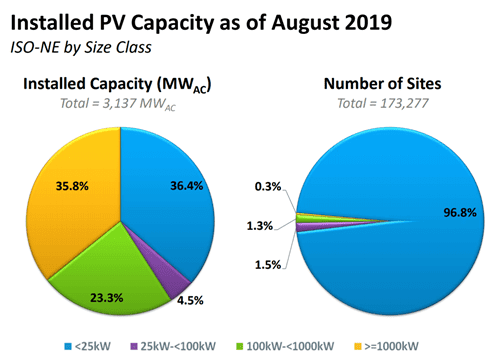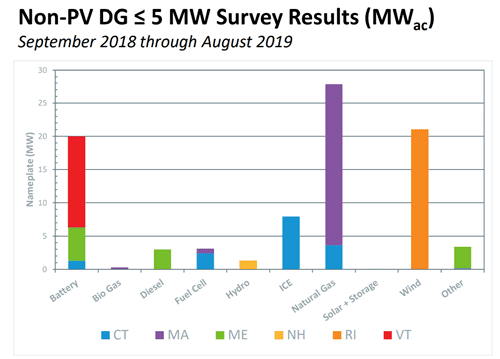Distributed Generation Forecast Working Group requests survey data for 2020 forecast
 ISO New England is calling for solar photovoltaic (PV) interconnection survey data from distribution owners for its 2020 distributed generation forecast, as announced at the December 5, 2019, meeting of the Distributed Generation Forecast Working Group (DGFWG). Survey data for all of 2019 must be sent to ddfwgsurvey@iso-ne.com by January 21, 2020. Here are other key milestones for the 2020 DG forecast:
ISO New England is calling for solar photovoltaic (PV) interconnection survey data from distribution owners for its 2020 distributed generation forecast, as announced at the December 5, 2019, meeting of the Distributed Generation Forecast Working Group (DGFWG). Survey data for all of 2019 must be sent to ddfwgsurvey@iso-ne.com by January 21, 2020. Here are other key milestones for the 2020 DG forecast:
- February 14: Discuss draft forecast
- March 20: Issue final draft forecast
- May 1: Post forecast as part of 2020 Capacity, Energy, Loads, and Transmission Report
What is DG?
Distributed generation includes the relatively small (≤5 megawatt) generation units connected directly to retail distribution or customer facilities, not the bulk power system. They can include PV panels—the largest component of DG—as well as small wind farms, biomass facilities, battery storage units, and other small sources. The amount of DG in the region can affect long-term system planning, such as by reducing the amount of capacity the system must have three years in the future and by eliminating the need to install new transmission or distribution facilities. It can also affect system operations, such as by reducing peak demand on sunny days. Read more about DG interconnection.
How levels are estimated
To estimate the level of distributed generation in New England, the ISO—with input by stakeholders participating in the DGFWG, including state policymakers, DG program administrators, and distribution companies—develops an annual DG forecast.
This forecast accounts for the state policies providing incentives to invest in these facilities and stimulate DG growth. While the DG measures vary in each state, they include rebates, grants, and tax credits; residential solar investment programs and renewable energy funding; zero- and low-emissions renewable energy credits; Renewable Portfolio Standards; “clean energy” pilot programs; net metering and billing; and other policies.
December check-in
At the December 5 meeting, representatives from each New England state presented updates on their programs and pending changes that may affect the amount of DG developed in their states and thus the 2020 DG forecast. Also at the meeting, the ISO presented midyear DG survey results, including the total PV capacity installed in the region as of August 2019 and non-PV distributed generation ≤ 5MWac from September 2018 to August 2019:


While some stakeholders expressed interest in the ISO conducting a forecast of behind-the-meter (BTM), distributed energy storage, the ISO relayed that this effort will require all the following to be in place:
- Ability to forecast the total amount of storage over the next 10 years
- Ability to account for storage that will be market-facing (i.e., not a load reduction)
- Data that provides sufficient visibility into the operating characteristics of BTM storage for determining its impacts to energy and demand and for proper forecasting accounting
The ISO is monitoring the growth of BTM storage and will report its findings to the DGFWG at a future meeting. For this effort, the ISO may need to work with distribution owners to evaluate whether it is receiving sufficiently comprehensive data on storage interconnection and to improve data collection as necessary.
- Categories
- Market Participant Information
- Tags
- solar
